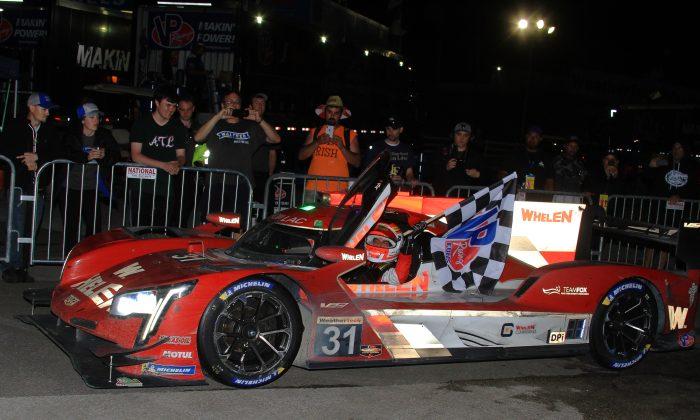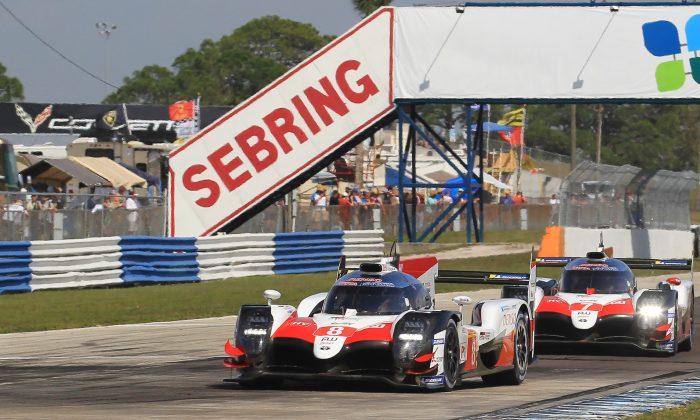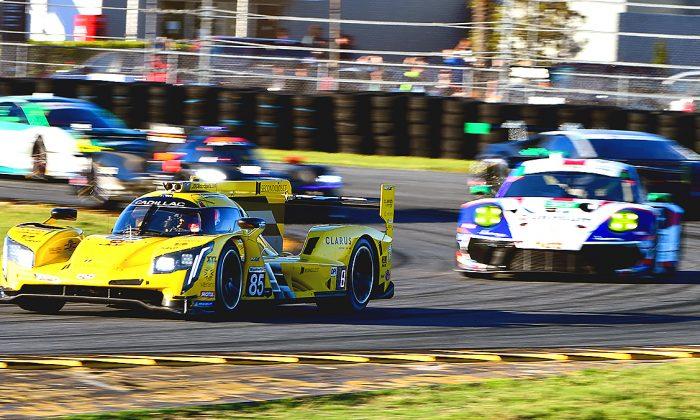After winning the season-opening Six Hours of Silverstone, Audi came to the Six Hours of Spa intent on continuing to win, while Toyota came to even the 2103 World Endurance Championship series. Audi succeeded, sweeping the podium after the fastest Toyota had to retire.
Audi and Toyota brought their latest Le Mans cars to Belgium’s Spa-Francorchamps course Saturday, May 4, to contest the second round of the FIA-WEC World Endurance Championship. Both manufacturers wanted to win, but more important, both wanted to test their 2013 long-tail models before the most important event of the season the Le Mans 24 Hours.
After six hours of racing, the podium was all Audi; the R18s #1,2, and 3 finished one-two-three in the race.
“What a race! The one-two-three win for Audi is fantastic,” race winner Lotterer told Audimotorsports.com.
“We had a lot of obstacles in the race. I didn’t have a good start but quickly managed to gain an advantage, but then we lost it again due to the safety car period and the puncture. After that, it was only full throttle for us.
“Marcel [Fässler] and Benoît [Tréluyer, Lotterer’s co-drivers] drove brilliantly. We recovered the loss. It was one of the nicest victories because it was a hard-fought one. And I grew up in Belgium and won here for the first time.”
Audi’s R18 “langheck” version wasn’t well suited to the track, not making enough downforce, but the sprint version worked beautifully, finishing in the top two positions, leaving the long-tailed Le Mans version to take third.
The Audis had basically a trouble-free race—the sort of showing that gives the phrase “run like Audi” meaning in the endurance-racing community. Cars, crew and driver all performed almost flawlessly. There were only two slight hitches: pole-sitter André Lotterer ran wide the first time through La Source hairpin, letting the other Audis and both Toyotas past.
Lotterer wasted no time in catching back up; fifteen minutes into the race he was back in second after Nicholas Lapierre in the #7 Toyota also ran wide. Lotterer went off shortly after while passing GT traffic.
The track seemed to be exceptionally dusty as several cars ran wide at several corners early in the race. That wasn’t the cause of the race’s only safety-car period—that came after an hour when Anthony Pizzonia in the #25 P2 Delta-ADR Oreca-Nissan suffered a rear-suspension failure exiting Eau Rouge, spinning hard into the tier barrier.
Benôit Tréluyer, Lotterer’s co-driver in the #1 Audi suffered a slow puncture just before the end of the caution period, and had to pit on the first green-flag lap, dropping the car back to sixth. That didn’t prove to be too much of a deficit; Tréluyer, Lotterer third driver Marcel Fässler worked their way back into second place by the halfway mark of the six-hour race, and took the lead on lap 90 when the leading Toyota pitted.
After the #7 Toyota retired, Audi owned the race, and Lotterer, Tréluyer, and Fässler proved to be the quickest of the Ingolstadt drivers. Their winning margin was more than a minute over the #2 of Allan McNish, Tom Kristensen, and Loic Duval, and nearly two minutes over the #3 langheck of Alex Di Grassi, Oliver Jarvis, and Marc Gené.
Speedy Toyota Suffers Hybrid Failure
Toyota had horrible qualifying sessions; the new-for-2013 TS030 Hybrid longtail #7 didn’t have enough downforce, while the 2012-model #8 with sprint-race bodywork had too much.
Toyota engineers worked overnight to retune the #7, and they succeeded; the car was fastest on the course in the first half of the race, hitting 308.6 kph (191.8 mph) through the speed trap. The Toyotas also seemed to have an edge in fuel economy; the #8 car finished the race on seven stops while the Audis needed eight. Had the new model lasted, the #7 Toyota likely would have finished first.
Unfortunately after three-and-a-half hours the car made the first of two unscheduled pit stops—the energy recover system malfunctioned, causing the rear brakes to overheat. Kaz Nakajima brought the car in to have the brakes cooled, but no one had a solution. Two laps later the car was in the pits again, and then went straight to the garage; the problem was terminal.
“I think our race performance was more competitive than we imagined after qualifying,“ said kaz nakajima, co-driver of the No.7, to Toyota-motorsports.com. ”Until the problem things looked pretty good and we were fighting with the Audis. I had a good first stint but the second stint was a little difficult due to the traffic.
“As a preparation for Le Mans it’s better that this issue happened today rather than in the 24 Hours. I hope we can find the reason for that and avoid a repeat. Now we focus on Le Mans.”
Toyota and Audi both use hybrid combustion/electric power systems, which scavenge otherwise wasted friction from braking to charge a battery (Audi) or a super-capacitor (Toyota) which ten drives electric motors for added acceleration leaving corners.
When everything works, the hybrid systems give the cars a few hundred extra horsepower at no cost in fuel, but like any part a racing car, these ERS systems are stressed to the very limit of engineering ability, and sometimes beyond. Better for Toyota to lose a car at Spa than to have one fail at Le Mans, which is the focus of the whole season.
The loss of the fastest Toyota did take some of the tension out of the race. Before its failure, the #7, in the hands of Nicholas Lapierre, spent 45 minutes racing nose-to-tail with Benôit Tréluyer, and the Toyota managed to keep the lead despite the best efforts of the Audi driver. After the Toyota’s retirement, the only question was which Audi would win.
Ferrari Fights Aston, Penalties to Win GTE-Pro
GTE-Pro was a four-way fight between Ferrari, Aston Martin, Porsche, and the race director; Ferrari came out ahead in the end.The pair of Aston Martin V8 Vantages of Aston martin Racing were evenly matched by the two AF Corse Ferraris; the two Porsche Team Manthey cars had better mileage but less top speed and more tire wear. The Ferraris held the lead after 45 minutes with the two Astons right behind; the cars were maybe a few meters apart, or closer, and surprisingly there was no contact despite all the drivers pushing hard.
The caution period after one hour upset things; the Astons and Porsches all refueled the pits were supposed to be closed under the new regulations. It took race control several hours to work out what had happened; after reviewing the record and talking with the teams, all four cars were given stop-and-go penalties with 45 minutes to go.
Long before that the leading #51 Ferrari shot itself in the foot repeatedly. Giancarlo Fisichella was first to earn a penalty, driving through the Eau Rouge runoff repeatedly. The extra width let him carry more speed, but it is only supposed to be used in emergencies, and the race director thankfully enforced the rules strictly. Many cars were penalized, but only the #51 Ferrari lost the class lead because of it.
Gianmaria Bruni took over in the #51 Ferrari, and retook the lead an hour later; Tony Vilander in the #71 Ferrari was second, with the #98 Aston of Bruno Senna third and the #91 Manthey Porsche of Timo Bernhard fourth.
Twelve minutes later Bruni was penalized again, this time for overtaking during the safety-car period.
By the halfway point, Bruni had worked the Ferrari back into second behind his team mate Toni Vilander in the #71.
This order stayed the same until 90 minutes from the end, when Stefan Mücke in the #97 Aston took the class lead ahead of Bruni and Vilander. That only lasted ten minutes; as pit stops cycled through, Bruni in the #51 found himself again in the class lead with the #71 behind him.
Forty minutes later, Bruni managed to collide with the #91 Manthey Porsche. The Porsche, which was already having mechanical issues, had to retire, but Bruni also had to pit, giving up the lead yet again. This time Bruni was not penalized—though judging from replays, he should have been—but he fell to third in class behind the two Astons, the #98 with Frank Makowiecki behind the wheel and the #97 driven by Darren Turner.
Before Bruni could digest his setback, the penalties for the Porsche and Astons were announced, and suddenly Bruni was back in front.
Bruni brought the #51 home ten seconds ahead of Makowiecki; Kamui Kobayashi in the #71 Ferrari was only a second behind the Aston at the finish; had the race lasted three laps longer Ferrari might have had the sweep.




